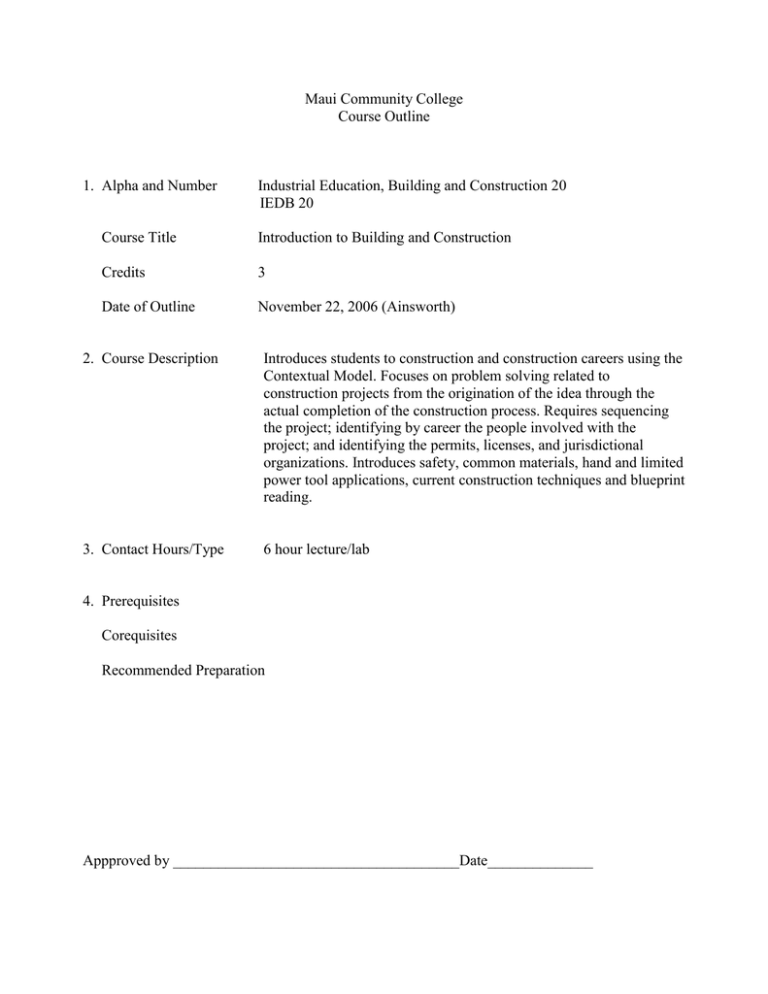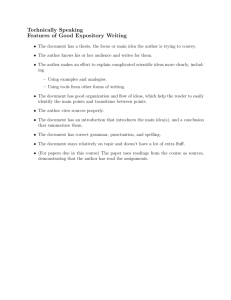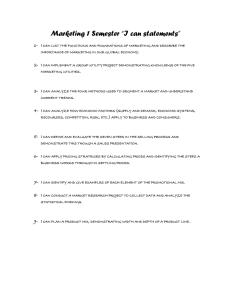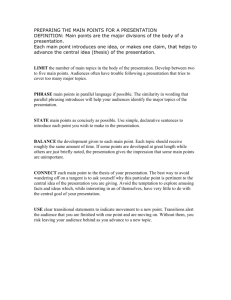SP07 Addition
advertisement

Maui Community College Course Outline 1. Alpha and Number Industrial Education, Building and Construction 20 IEDB 20 Course Title Introduction to Building and Construction Credits 3 Date of Outline November 22, 2006 (Ainsworth) 2. Course Description Introduces students to construction and construction careers using the Contextual Model. Focuses on problem solving related to construction projects from the origination of the idea through the actual completion of the construction process. Requires sequencing the project; identifying by career the people involved with the project; and identifying the permits, licenses, and jurisdictional organizations. Introduces safety, common materials, hand and limited power tool applications, current construction techniques and blueprint reading. 3. Contact Hours/Type 6 hour lecture/lab 4. Prerequisites Corequisites Recommended Preparation Appproved by ______________________________________Date______________ 5. General Course Objectives Introduces students to construction related careers via Construction Academy experiences. Course fulfills a requirement for a Certificate of Competence in Basic Carpentry, a Certificate of Completion in Introductory Sustainable Construction Technology, and an Associate in Applied Science in Sustainable Construction Technology. 6. Student Learning Outcomes For assessment purposes, these are linked to #7recommended Course Content. On completion successful completion of this course the student will be able to: a. demonstrate quality work; b. demonstrate knowledge of personal and professional career opportunities in Building and Construction, and outline a personal career path; c. demonstrate personal and professional health, fitness and safety practices required for the building and construction occupations; d. explain how to interact with customers and coworkers on construction jobs in ways that effectively support the work to be accomplished and promote customer satisfaction; e. prepare a working drawing, calculate specifications, and manage the office/business aspects of a construction project; f. use appropriate materials, tools, equipment, and procedures to carry out work on construction projects. 7. Recommended Course Content and Approximate Time Spent on Each Topic Linked to #6 Student Learning Outcomes. 1 - 2 Weeks Appropriate standards for efficiency, technique, style, and product ( a) Need for customer satisfaction (d) Customer survey to identify a marketable construction Project (b, d) 1 - 2 Weeks Conducting an online research project to identify levels of education, training and certification requirements for each occupation (b) Assessing personal knowledge, skills and interests to determine which careers would be appropriate (b) Choosing a career and complete a four-year academic and five-year professional plan (b, c) 2 - 3 Weeks Importance of maintaining a drug free lifestyle, and mental clarity (a, c) Demonstrating stamina by performing required physical tasks (a, c) Conducting an onsite evaluation and designing a safety plan for jobsite (a, c) 2 - 3 Weeks Communicating effectively with instructors, co-workers & customers (d) Demonstrating interpersonal skills including equity, good attendance, and promptness, proper dress, and hygiene (c, f) 2 - 3 Weeks Developing a working drawing with written specifications (e, f) Using math skills solving problems related to construction plans (e) Interpreting orthographic and pictorial symbols (e, a) 2 - 3 Weeks Demonstrating proper identification and use of construction materials (f) Demonstrating knowledge and proper use of tools and equipment (f, a) Design, construct, and finish a marketable project that uses a variety of materials, tools, & procedures by industry standards. (a,b,c,d,e,f) 8. Text and Materials, Reference Materials, Auxiliary Materials and Content Suggested appropriate textbooks such as: Huth, Mark W. (2004). Basic principles for construction. (Residential Construction Academy.) Clifton Park, NY: Thomson Delmar Learning. National Center for Construction Education and Research. (2002). Core curriculum. Upper Saddle River, NJ: Prentice Hall 9. Recommended Course Requirements and Evaluation Attendance and class participation Reports and Presentations Research/Projects. Final Test Quality Workmanship 10. Methods of Instruction Lecture and discussions Inquiry activities Problem solving Group projects Individual projects Examinations with discussion and feedback 30-40% 25-30% 20-30% 0-15% 10-15% Assessment of Intended Student Learning Outcomes Standards IEDB 20 Standard 1 - Written Communication Outcome 1.1 - Use writing to discover and articulate ideas. Outcome 1.2 - Identify and analyze the audience and purpose for any intended communication. Outcome 1.3 - Choose language, style, and organization appropriate to particular purposes and audiences. Outcome 1.4 - Gather information and document sources appropriately. Outcome 1.5 - Express a main idea as a thesis, hypothesis, or other appropriate statement. Outcome 1.6 - Develop a main idea clearly and concisely with appropriate content. Outcome 1.7 - Demonstrate a mastery of the conventions of writing, including grammar, spelling, and mechanics. Outcome 1.8 - Demonstrate proficiency in revision and editing. Outcome 1.9 - Develop a personal voice in written communication. 1 1 1 2 1 1 0 0 0 Standard 2 - Quantitative Reasoning Outcome 2.1 - Apply numeric, graphic, and symbolic skills and other forms of quantitative reasoning accurately and appropriately. Outcome 2.2 - Demonstrate mastery of mathematical concepts, skills, and applications, using technology when appropriate. Outcome 2.3 - Communicate clearly and concisely the methods and results of quantitative problem solving. Outcome 2.4 - Formulate and test hypotheses using numerical experimentation. Outcome 2.5 - Define quantitative issues and problems, gather relevant information, analyze that information, and present results. Outcome 2.6 - Assess the validity of statistical conclusions. 2 2 3 0 0 0 Standard 3 - Information Retrieval and Technology Outcome 3.1 - Use print and electronic information technology ethically and responsibly. Outcome 3.2 - Demonstrate knowledge of basic vocabulary, concepts, and operations of information retrieval and technology. Outcome 3.3 - Recognize, identify, and define an information need. Outcome 3.4 - Access and retrieve information through print and electronic media, evaluating the accuracy and authenticity of that information. 1 1 2 1 Outcome 3.5 - Create, manage, organize, and communicate information through electronic media. Outcome 3.6 - Recognize changing technologies and make informed choices about their appropriateness and use. 1 1 Standard 4 - Oral Communication Outcome 4.1 - Identify and analyze the audience and purpose of any intended communication. Outcome 4.2 - Gather, evaluate, select, and organize information for the communication. Outcome 4.3 - Use language, techniques, and strategies appropriate to the audience and occasion. Outcome 4.4 - Speak clearly and confidently, using the voice, volume, tone, and articulation appropriate to the audience and occasion. Outcome 4.5 - Summarize, analyze, and evaluate oral communications and ask coherent questions as needed. Outcome 4.6 - Use competent oral expression to initiate and sustain discussions. 2 2 2 2 2 2 Standard 5 - Critical Thinking Outcome 5.1 - Identify and state problems, issues, arguments, and questions contained in a body of information. Outcome 5.2 - Identify and analyze assumptions and underlying points of view relating to an issue or problem. Outcome 5.3 - Formulate research questions that require descriptive and explanatory analyses. Outcome 5.4 - Recognize and understand multiple modes of inquiry, including investigative methods based on observation and analysis. Outcome 5.5 - Evaluate a problem, distinguishing between relevant and irrelevant facts, opinions, assumptions, issues, values, and biases through the use of appropriate evidence. Outcome 5.6 - Apply problem-solving techniques and skills, including the rules of logic and logical sequence. Outcome 5.7 - Synthesize inform from various sources, drawing appropriate conclusions. Outcome 5.8 - Communicate clearly and concisely the methods and results of logical reasonong. Outcome 5.9 - Reflect upon and evaluate their thought processes, value system, and world views in comparison to those of others. 2 1 0 2 1 2 1 0 0


